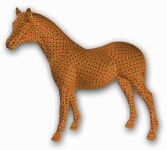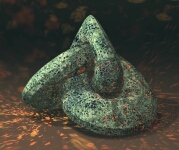- publication
- IEEE Visualization 2002
- authors
- Olga Sorkine-Hornung, Daniel Cohen-Or, Rony Goldenthal, Dani Lischinski

A bell pepper model flattened into one large piece with bounded distortion. The 3D object is shown on the left with a checkerboard texture demonstrating the low distortion of the parameterization. Seams introduced by our algorithm are shown in red. The right image shows the flattened surface, visualizing the amount of distortion introduced by the mapping across the mesh.
abstract
Many computer graphics operations, such as texture mapping, 3D painting, remeshing, mesh compression, and digital geometry processing, require finding a low-distortion parameterization for irregular connectivity triangulations of arbitrary genus 2-manifolds. This paper presents a simple and fast method for computing parameterizations with strictly bounded distortion. The new method operates by flattening the mesh onto a region of the 2D plane. To comply with the distortion bound, the mesh is automatically cut and partitioned on-the-fly. The method guarantees avoiding global and local self-intersections, while attempting to minimize the total length of the introduced seams. To our knowledge, this is the first method to compute the mesh partitioning and the parameterization simultaneously and entirely automatically, while providing guaranteed distortion bounds. Our results on a variety of objects demonstrate that the method is fast enough to work with large complex irregular meshes in interactive applications.
downloads
- Paper (IEEE Visualization 2002, official version available at http://ieeexplore.ieee.org/)
- BibTex entry
- Talk slides
some results
The different patches of the partition are visualized using distinct colors. The distortion threshold was set to 1.5 (which means that the maximal stretching/shrinking factor of a unit length vector in the parameter domain is 1.5). The growth of a patch was stopped when area to squared perimeter ratio exceeded 20.
Click on the individual images to see a larger version.
texture mapping with our parameterization
Click on the individual images to see a larger version.
The horse farm:
Twisted knot:
3D painting with our parameterization
Click on the individual images to see a larger version.
Rony's artwork
Our entries into the CGF cover competition. Click on the individual images to see a larger version.
acknowledgments
This work was supported in part by the Israel Science Foundation founded by the Israel Academy of Sciences and Humanities, by the Israeli Ministry of Science and by a grant from the German Israel Foundation (GIF). We would like to thank Ronen Gvili, Roman Manevich and Adi Karol for helping us developing parts of the code, and Alla Sheffer and Gershon Elber for reviewing an early version of this work.






















